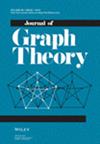Dense circuit graphs and the planar Turán number of a cycle
IF 1
3区 数学
Q2 MATHEMATICS
引用次数: 0
Abstract
The planar Turán number of a graph is the maximum number of edges in an -vertex planar graph without as a subgraph. Let denote the cycle of length . The planar Turán number is known for . We show that dense planar graphs with a certain connectivity property (known as circuit graphs) contain large near triangulations, and we use this result to obtain consequences for planar Turán numbers. In particular, we prove that there is a constant so that for all and . When this bound is tight up to the constant and proves a conjecture of Cranston, Lidický, Liu, and Shantanam.

密集电路图和循环的平面图兰数
图的平面图兰数是一个无顶点平面图的最大边数。让 表示长度为 的循环。平面图兰数是已知的。我们证明了具有一定连通性的密集平面图(称为回路图)包含大的近三角形,并利用这一结果得到了平面图兰数的结果。特别是,我们证明存在一个常数,使得对于所有 和 。当这一约束严格到常数时,就证明了 Cranston、Lidický、Liu 和 Shantanam 的猜想。
本文章由计算机程序翻译,如有差异,请以英文原文为准。
求助全文
约1分钟内获得全文
求助全文
来源期刊

Journal of Graph Theory
数学-数学
CiteScore
1.60
自引率
22.20%
发文量
130
审稿时长
6-12 weeks
期刊介绍:
The Journal of Graph Theory is devoted to a variety of topics in graph theory, such as structural results about graphs, graph algorithms with theoretical emphasis, and discrete optimization on graphs. The scope of the journal also includes related areas in combinatorics and the interaction of graph theory with other mathematical sciences.
A subscription to the Journal of Graph Theory includes a subscription to the Journal of Combinatorial Designs .
 求助内容:
求助内容: 应助结果提醒方式:
应助结果提醒方式:


